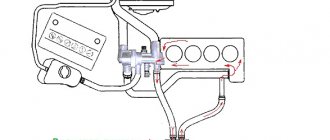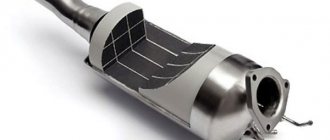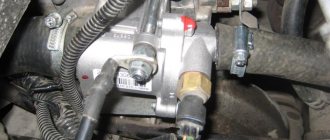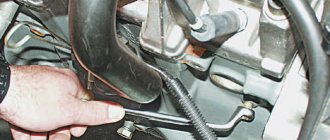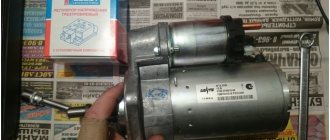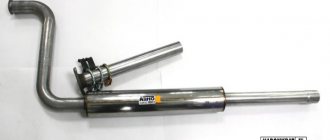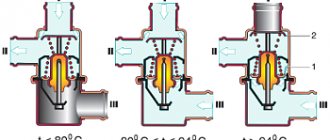Replacing the thermostat
Suddenly the engine began to heat up, and the fan did not work; at a temperature of 110 degrees, I touched the radiator pipe, but it was cold! The thermostat is stuck on the small circle. I bought a new one from Luzar; my friends who used it on the Internet did not praise it, but unfortunately there were no others in the store.
By chance, the opportunity arose to change it in a garage, with a pit and all the amenities (thanks to friends), otherwise I didn’t want to mess around outside in the cold, and it’s not aesthetically pleasing to pour antifreeze down a tray)))
Here is a list of tools and spare parts needed for the job:
1. Ratchet 2. Heads for 10, 17 and 19 3. Curved screwdriver 4. New thermostat 5. Empty container for draining coolant
We put the car in a pit to drain the antifreeze (although you can drain the coolant on the ground, but I liked the option with a pit much better, my pan is dirty, and the coolant does not drain evenly from the radiator along it, just have time to catch it) .
Using sockets 19 and 17 we unscrew the 2 bolts and 2 nuts securing the engine oil pan, and also with a socket 10 we unscrew the crankshaft pulley protection
Here is the plug in the radiator for draining antifreeze, unscrew it
We place a board across the pit and place a cut container under the radiator cap, in my case it was a 5 liter bottle
Now we slowly unscrew the cap of the coolant expansion tank until antifreeze runs out of the radiator, adjust the pressure force as necessary and wait until the coolant is drained into the container, tighten the radiator cap.
After draining the antifreeze, you can begin dismantling the faulty thermostat. For ease of dismantling, we need to remove the air filter, just unscrew the two bolts securing the filter to the car frame, loosen both clamps on the pipe, disconnecting it from the filter and move the filter itself to the right as shown in the figure below. , not forgetting to disconnect the connector of the mass air flow sensor,
We also disconnect the connector of the phase sensor and coolant temperature sensor, move the wiring to the side, here it is our old and faulty thermostat
(came a little out of focus)
Based on numerous tips, I decided to coat the flanges of the new thermostat with lithol instead of applying sealant, I don’t know if this is correct or not, I just decided to try
When installing a new thermostat, we replace the old and hard pipes and clamps with new ones, I replaced only one, a short one, since it was in poor condition, I left the old clamps (because I forgot to buy new ones)))))
The thermostat is installed, the pipes are dressed and tightly tightened with clamps, do not forget to connect all the disconnected connectors to the sensors, put the air filter in place and tighten the clamps on the pipe, now you can fill in antifreeze, to do this, loosen the clamp on the throttle hose and start pouring antifreeze until it comes out of the hose coolant will flow (this is done to keep the system from airing).
After this, we put the hose on the throttle and tighten the clamp, adding coolant to the required level.
You can check, we start the car and wait until it warms up, in my case the thermostat worked almost exactly as it says on the package, a large circle opens up the radiator pipe is hot, everything worked out, now my temperature does not exceed 90 degrees and the antifreeze does not squeeze out from the expansion tank.
I wish you all successful and smooth roads, without breakdowns!
Features of the VAZ-2115 thermostat and its operating principle
The thermostat is an essential element in a vehicle's cooling system. A new domestically produced part can withstand from 80,000 kilometers to 100,000 kilometers, and an imported one - about 120,000 kilometers. It is very important that the thermostat is of high quality, so it is necessary to purchase it for replacement in specialized auto stores.
A car thermostat controls the temperature of the coolant (for example, antifreeze), and distributes it among circulation circles - small and large. If the vehicle engine and cooling fluid are cold, the thermostat valve will be closed, allowing the small circulation circle to operate.
As soon as the optimal temperature regime of the cooling liquid is reached, the thermostatic valve will operate, that is, it will open and a large circulation circle will come into effect.
The flow of coolant will enter the radiator, and the temperature will stop increasing, and its level will stabilize - optimally 90 degrees. This is the principle of operation of the thermostat element in good condition.
When does a thermostat need to be replaced?
For proper operation of a vehicle, it is important that the temperature of its engine is within the same limits. This can be achieved through the use of coolant - antifreeze or antifreeze - and the proper operation of the entire cooling system of the car. As soon as the temperature begins to exceed the required limits (most often it is 90 degrees), you should check the car thermostat for serviceability. If it turns out that this part is out of order, then there will be a need to replace it with a new one.
The best manufacturers
When choosing a thermostat, keep in mind that AvtoVAZ does not produce these devices, but purchases them from partner companies, so if you see that the packaging says “manufactured by AvtoVAZ JSC” and there is no indication of the real manufacturer, then this is a fake. It is very difficult to make an objective rating of thermostats for VAZ 2110 or any other cars, because the operation of this device depends on many factors, including the condition of the engine cooling system. However, according to reviews from owners of VAZ 2108–2115 cars, we have ranked the manufacturers as follows:
We replace the thermostat on a VAZ-2115 ourselves
According to experts, the procedure for replacing a thermostat takes about an hour if tools and consumables are available. Therefore, you should take care of this before carrying out this operation. You will need the following:
- Tools:
- standard car mechanic kit (screwdrivers of various sizes and configurations);
- capacity of more than 7 liters for draining liquid waste.
- Materials:
- new thermostat;
- heat-resistant sealant;
- set of gaskets for repair;
- antifreeze or antifreeze (as a coolant).
Now you can begin the procedure for replacing the failed thermostat element, which consists of the following steps.
- Preliminary – stage of preparing the vehicle for the repair procedure:
- the car is installed on an inspection hole or on a flat surface;
- the engine is turned off;
- put on the handbrake;
- the engine is cold.
- Removing the old thermostat element:
- unscrew the expansion tank cap;
- open the radiator tap to drain the coolant from it;
- drain the coolant into a prepared container;
- remove the air filter (at the same time carry out a visual inspection for any malfunctions of this part);
- loosen the clamps of the radiator pipes;
- disconnect the hoses from the radiator and from the thermostat element;
- unscrew the fastening bolts (4 pieces);
- remove the thermostat (it is removed together with the seal ring).
- Installation of a new thermostat:
- lubricate the perimeter of the circuit with heat-resistant sealant;
- install a new sealing ring;
- put a new gasket;
- install a new thermostat;
- connect all hoses;
- tighten the clamps tightly;
- screw the plug on the drain valve at the bottom of the radiator;
- fill with coolant.
- Verification stage:
- start the vehicle;
- check for possible leaks;
- warm up the car to the optimal temperature - more than 90 degrees (this operation is necessary for the large circle of the cooling system to start);
- We check all hoses and pipes in operating mode - they should be hot.
A nuance of a working thermostat on a VAZ-2115: when starting a still cold engine, the lower pipe on the radiator will begin to heat up already at 85 degrees of coolant.
This can be determined by touch. To fully ensure that the newly installed thermostat element is functioning at the proper level, you should also turn on the heating element - the stove. If there are no failures or leaks in this mode, then the thermostat is installed correctly and without errors.
If you are not confident in your abilities, then to replace this part you should seek help from qualified specialists, that is, to the nearest car service center.
Determination of malfunction and list of new parts
It is quite easy to detect a faulty part when the engine starts to overheat, just touch the lower pipe on the radiator of the cooling system, and if it turns out to be not very hot, this will mean that the thermostat valve on the VAZ 2114 has failed and requires urgent replacement.
To carry out repairs you must purchase:
- new thermostat assembly (art. 21082-1306010-83);
- upper radiator pipe (art. 21120-0-1303010-86);
- lower radiator pipe (art. 21120-0-1303010-86)
- thermostat pipe (art. 2108-1303092-R);
- expansion barrel pipe (art. 21120-0-1303010-86)
- metal pipe clamps 5 pcs.;
- new antifreeze;
- sealant for reliable fixation.
Replacing the thermostat on VAZ 2113, 2114, 2115 cars with fuel injection is carried out using some tools, namely:
- two open-end or socket wrenches 12 and 13 mm;
- Screwdriver Set;
- container for draining coolant;
- protective gloves for hands.
The price for replacing a faulty thermostat on a VAZ 2114, which will need to be paid at official Lada car repair shops, this fall is approximately 1,500 - 2,000 rubles (excluding the cost of new parts). In small private garage-type auto repair shops, this work is estimated at 1000 rubles.
The work itself is not difficult, and if you have high-quality spare parts and tools, any owner of a VAZ 2113, 2114 or 2115 will be able to carry out repairs on their own, for which you need to watch a video on replacing the thermostat on an injection model, or carefully study the stages of this process below.
The operating principle of the thermostat VAZ 2115, 2114, 2113, 2109
What does a thermostat consist of? Let's get a look!
The thermostat consists of a housing, a bypass valve, a main valve, a temperature sensing element (usually located near the main valve) and a spring.
How does the thermostat work on VAZ 2115, 2114, 2113, 2109
When the car is not warmed up, the thermostat valve is closed, as in the photo. In this case, the coolant moves in a small circle, as in the photo below.
When the machine warms up to operating temperature (87-90 degrees), the temperature-sensitive element slowly begins to heat up, as a result of which the spring compresses, the main valve opens and the liquid flows in a large circle.
Design
The VAZ-2115 temperature sensor is a thermistor with a negative temperature coefficient. This means that its resistance decreases as the engine warms up. This is very convenient because you can connect an ammeter, calibrated accordingly, in series and get a simple temperature indicator without additional transformations.
This is exactly the scheme that is used in the fifteenth model. In addition, the fluid temperature sensor in the VAZ-2115 is connected to an electronic control unit (ECU). Thus, the computer receives information about the thermal conditions of the engine and makes adjustments to the composition of the working mixture. But that's not all. In the “tag”, as in any car with an injection engine, there is no separate sensor for turning on the fan. It is launched by a signal from the ECU in accordance with the data received from the DTOZH.
How to understand that the thermostat of the VAZ 2115, 2114, 2113, 2109 is faulty?
There are two reasons why you can understand that the thermostat on the VAZ 2115, 2114, 2113, 2109 is faulty:
- The car does not warm up.
- The car overheats and boils.
There are also two ways to check the thermostat:
- Check the removed thermostat for functionality.
- Check the thermostat without removing it from the car.
Let's take a closer look at each of the options.
How to check the removed thermostat of a VAZ 2115, 2114, 2113, 2109 for functionality?
In theory, everything is simple. Take a pan with cold water, a thermometer up to at least one hundred degrees and a thermostat. We put it all on the tile to warm up and wait... We wait until the water temperature reaches 85 degrees, at which point we begin to look at the main thermostat valve. At 87 degrees it should open. If it does not open or opened earlier, then the thermostat is faulty.
How to check the thermostat of VAZ 2115, 2114, 2113, 2109 without removing it from the car?
A prerequisite in this case is that the car must be cold. After starting the engine, grab the lower pipe coming from the radiator with your hands. Until the temperature reaches 80 degrees it should be completely cold. When it reaches 85 degrees, the tube should begin to warm up slowly. And when 90 degrees is reached, full circulation of hot coolant should begin (i.e. the valve is completely open). The lower tube should be hot.
It happens that immediately after starting the engine, when it has warmed up only 50 degrees, warm liquid begins to flow through the lower tube. This shouldn't happen either!!! This means that the valve is constantly open.
I hope my article helped you solve your problem. If you have any questions, leave them in the comments and I will definitely answer them.
Where is DT located?
This will probably be a revelation for many, but there are two temperature sensors in the VAZ-2115. One of them is installed on the thermostat and works in full cooperation with the on-board computer. The other is designed to operate a dial gauge indicating temperature. It is located at the end of the cylinder head and is screwed into it horizontally. The sensors are similar in principle of operation, but differ in design. The one installed in the thermostat has two contacts for connection. The second connector of the instrument cluster sensor is the vehicle ground.
Replacing the thermostat on VAZ 2113, VAZ 2114, VAZ 2115
Thermostat is an element of the cooling system that supplies coolant to a large circle at a certain temperature. The thermostat ensures that the engine runs correctly and does not get too hot. It is also responsible for warming up: if the thermostat is worn out and the fluid immediately comes out in a large circle, then the car takes a very long time to heat up (especially in winter), which means the car’s fuel consumption increases. Over time, a lot more problems will emerge, because running the engine for a long time on a cold engine is very destructive, and driving on a cold engine is even worse. There is a lot of load on the engine, lubricant does not reach all parts well, etc. If possible, in very cold weather (-25 and above, although -20 is already enough), we recommend not using the car at all if you want the engine to live a long enough life and not require major repairs in the near future.
Note! You will need the following tools: a couple of screwdrivers of different lengths with different heads (it is most convenient to use a short screwdriver), a large wide container with a capacity of approximately 10 liters, a small saucepan (fill with water and immerse the thermostat).
Thermostat location
On injection cars it is located under the air filter housing, on carburetor cars (the first VAZ 2115 were produced in a carburetor version for a couple of years) it is located in the same place, but the housing is moved to a slightly different place, so on the carburetor you don’t need to bother and remove the housing, but simply throw off the high-voltage wires and get started to work. In any case, do not be alarmed, the housing can be removed quickly and easily, read the article: “Replacing the air filter housing on VAZ cars.” After removing the housing, you will see the thermostat with the naked eye (indicated by a red arrow in the photo below), and next to it there is a battery (indicated by a blue arrow). We hope we have clearly explained the location of the thermostat and you can easily find it.
When is it necessary to change the thermostat?
Over time, it wears out and the valve begins to work incorrectly (usually it freezes in one position). The engine temperature will depend on the stuck position. There are two such provisions:
- The first is a fully open valve. Symptoms: the fluid comes out in a large circle, causing the car to heat up too much, which is not very noticeable in the summer, but noticeable in the winter, because The car doesn't really warm up.
- The second is a completely closed valve. Symptoms: the fluid runs in a small circle, the car gets very hot and when parked for a long time with the engine running, its temperature reaches the red mark.
A rare case - the valve is in the middle. Symptoms: the car does not warm up for too long, but it is noticeable over time even when parked for a long time with the engine running in the summer. It gradually overheats and the engine temperature slowly reaches the red mark. It happens that the cooling fan does not work and the thermostat does not come to a wide circle - be careful, the engine will overheat in a short period. Please note that 10 minutes of engine operation in the red zone leads to cylinder head failure. Longer load on the engine will lead to the need for a cap. repair.
Note! There is a method for checking the thermostat without removing it. Warm up the car to a temperature of 87-92 °C (and while the engine is cold, touch the lower pipe coming from the thermostat (photo below, indicated by number 6, it should always be cold until the engine reaches 87-92 °C). On a warm engine the lower hose should warm up.If the hose begins to warm up ahead of time or does not become warm at all, even at engine operating temperature, then the thermostat is faulty and needs to be replaced.
Idle speed control
A sensor that keeps the engine idling. It is a DC motor with a worm gear; there is a metal wedge on the shaft, which, if necessary, opens or closes the air channels of the throttle assembly. Installed on the throttle valve, secured with two screws to the body. Quite often it fails due to contamination of the shaft or aging of the sealing ring.
Signs of malfunction:
- Uneven idle speed;
- Long start of the internal combustion engine;
- Spontaneous engine stop;
Replacing the thermostat on a VAZ 2113-VAZ 2115
Note! The main thing is safety: do not work on a hot engine to avoid burns. Work only with a cold unit, especially when working with engine oil and coolant.
Removal
1) The first step is to drain the coolant from the cooling system. The engine cooling jacket does not need to be touched, and the liquid must only be drained from the radiator. We described detailed instructions in the article: “Replacing coolant on a VAZ 2114”). Unscrew the cap on the expansion tank (small photo), then cover the generator with something (indicated by the blue arrow) to prevent antifreeze from getting in. Contact with antifreeze can result in a short circuit. By the way, for safety reasons, disconnect the battery by disconnecting the terminals). Remove the engine protection, if equipped. Place an empty container under the front part (the location of the drain plug near the radiator, indicated by a red pointer). Unscrew the plug, the coolant will begin to flow into the empty container. After emptying the tank, screw the plug back into place and begin replacing the thermostat.
Note! If you have a new coolant (for example, they just changed it a month ago), then you can only drain it into a clean container and then pour it back into the car engine, nothing bad will happen from this, but if the fluid is already bad, then be sure to change it to new, don’t skimp on it, it protects the engine from overheating, as well as from corrosion (special additives are present in the fluid)!
2) Unscrew the screws holding the hoses with clamps (marked in red). Pay attention to the hose, the fastening screw of which is indicated by a blue arrow. It is removed together with the thermostat, so unscrew the screw securing it to the pipe (small photo) and remove the thermostat along with this short hose. Now unscrew the screw securing the hose to the thermostat and separate them from each other.
Installation
The thermostat is installed in the reverse order of removal. Cracked hoses are replaced with new ones, otherwise they may leak. Before installation, the thermostat is checked for serviceability (we strongly recommend this procedure). Water is poured into the pan and heated to a temperature of 78-80 °C (measured with a thermometer). Then the thermostat is immersed and when the temperature reaches 87+2 °C, it must begin to open, or rather its valve. We have indicated the details with arrows in the photographs.
Sources
- vaz-russia.com/remont-vaz-2113/zamena-termostata-na-vaz-2113-vaz-2114-vaz-2115.html
- vaz-zona.ru/kak-proverit-termostat-na-vaz-2115-2114-2113-2109/
- ladaautos.ru/vaz-2115/kak-proisxodit-zamena-termostata-vaz-2115.html
- drive2.ru/l/9032036/
- drive2.ru/l/4918112/
Fuel level sensor
Indicates the remaining amount of fuel in the tank. Installed directly in the tank on the fuel pump glass. It fails when the graphite contacts on the electrical board are rubbed. When replacing, you should pay attention to its type number, which is indicated on the board, since all types of FLS have different resistance. If an unsuitable sensor is installed, large errors in readings may occur.
Signs of malfunction:
- Incorrect readings about the presence of fuel in the tank;
